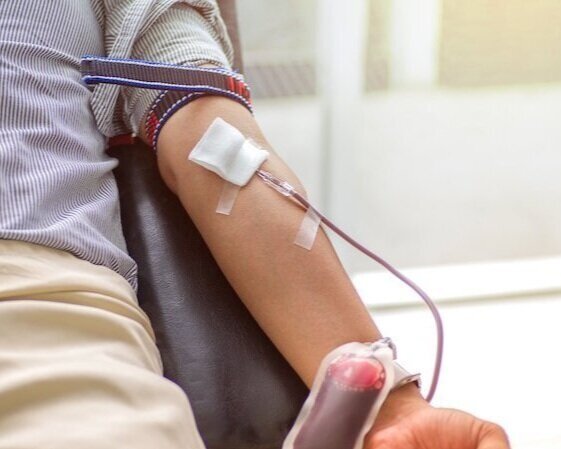Preparing for a Venesection.
What is a Venesection?
A venesection is the removal of blood to reduce the number of red blood cells circulating in the body and/or the removal of excess iron from your body, depending on your medical condition.
During a venesection, approximately 450ml of blood is removed in the same manner a blood donation is collected. This amount can vary depending on many factors that your doctor or treating nurse will discuss with you. How often a venesection is performed depends on your blood result and your Haematologist. This is why it is important to have a regular blood test. Venesections are used to treat:
Haemochromatosis: Where too much iron is absorbed into the body. Once iron is absorbed into the body it is unable to be excreted. Iron deposits can occur in organs resulting in disease. By removing blood, the level of iron in the blood is reduced and damage to the organs is minimised.
Polycythemia: Where the body produces too many red blood cells. When the number of red blood cells increases above normal levels the blood thickens and becomes sluggish increasing the risk for clots to develop. Blood clots can be life threatening if not treated appropriately. Venesections reduce the number of circulating red blood cells.
How is a Venesection performed?
A venesection is very similar to a blood donation. A tourniquet is placed around your arm and a needle is inserted into a vein within the elbow region. Approximately 450ml of blood is drained by gravity into a collection bag. Once the blood is flowing the tourniquet will be loosened slightly. This should take about fifteen minutes.
When the venesection is complete the needle will be removed and a piece of gauze placed on the puncture site. You will be asked to press on this for a few minutes. A band-aid will be placed onto the needle site and a bandage wrapped around your arm to prevent any further bleeding and reduce bruising. You will be given a drink of water and asked to stay at the practice for 15 minutes before you go home.
The nurse will then check blood pressure and observations again. When your blood pressure is stable you can be discharged. After leaving you should observe your venesection site for bleeding and signs of infection. You can resume all your normal activities after the procedure but avoid strenuous exercise for a day or two afterwards. Keep hydrated and drink two litres of fluid daily for 48 to 72 hours following your procedure.
On the day of your appointment:
We recommend that you eat normally and drink extra fluids prior to you appointment. Please advise your nurse if any of the following apply to you:
You are taking Anticoagulation medication
You are taking blood pressure medication (betablockers)
You have a heart condition
You have fainted or felt unwell after blood tests or previous venesections
You weigh less than 50kg
You are frightened of needles
If possible, arrange for someone to drive you home after your first venesection.
Possible side effects include:
Fainting and Tiredness - Immediately after the procedure you may feel dizzy and light headed. If this occurs during or after the procedure we will give you extra fluid and lay you down. You should feel better within a few minutes. To minimize the risk of feeling faint, always eat normally and keep well hydrated prior to the procedure.
Tiredness - You may feel tired following a venesection for a day or two. Avoid excessive exercise until the next day. Avoid smoking for 2 hours after a venesection
Bruising or Bleeding - On occasion bruising or bleeding may occur at the needle entry site. Keep the bandage that the nurse applies after the venesection in place for at least 2 to 4 hours to reduce bruising at the site. Avoid lifting anything heavy with the venesected arm for the rest of the day.
Pain - Venesections are not painful, but can be uncomfortable during needle insertion. We will offer you some numbing medicine prior to needle insertion.
Nerve Damage - It is possible, although rare to damage structures near the vein we are entering during a venesection. If a nerve is hit during the procedure it will be very painful, and you may feel pins and needles down your arm and into your hand. If you have any sensation or pain during the procedure it is important that you inform your treating nurse immediately.
Can the blood be used?
Blood collected by services apart from the Australian Red Cross Blood Service (ARCBS) is not suitable for general use and will be discarded. Haemachromatosis is not a contraindication to blood donation. If you are medically fit to donate according to ARCBS guidelines, you should donate via their service so that your blood may be used in the national blood supply.
What if I have problems after my venesection?
Please immediately contact your doctor or come to your local Emergency Department if you experience any of the following occur after your procedure:
bleeding
fever
redness at venesection site
smelly discharge from your venesection site
you feel insignificantly unwell in any way
In the unlikely event that you become extremely unwell after the procedure, dial 000 and ask for an ambulance.
Appointments
To make an appointment for Venesection, please call the Practice on 02 4739 6040 or make an online booking.
Please ensure you bring with you a current referral from your referring medical practitioner.

